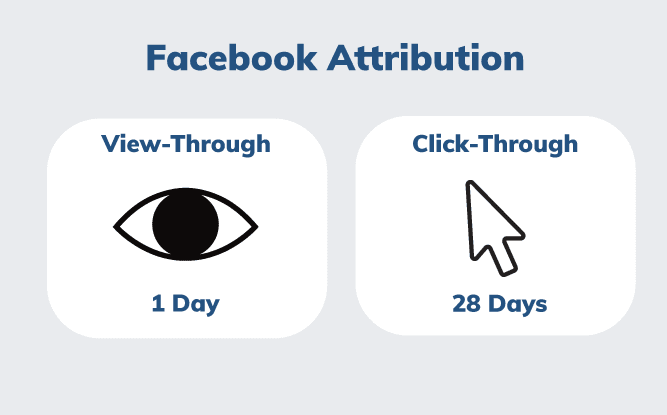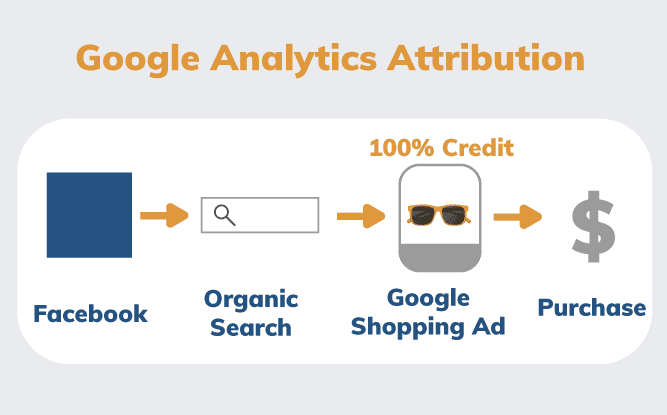Depending on your point of view, Facebook is either the best or the worst form of advertising. Looking at Facebook’s metrics alone, you’ll see many ads credited with driving conversions. However, if you compare these numbers to another platform such as Google Analytics, you will likely see vastly different results because Facebook tends to be very generous in its reporting. In this article, we will take a look at how to account for over-reporting on Facebook and determine whether Facebook or Google Analytics attribution models are better for your business.

Who Gets Credit for the Sale?
Let’s consider a scenario. Imagine a user is scrolling Facebook and they see your ad for sunglasses. They click on the ad but decide not to purchase. A week later, that same user remembers your ad and searches for your business on Google. After performing this search, the user clicks on a Google Shopping ad and buys the sunglasses. In this situation, who should get credit for the sale: Facebook or Google Ads?

Decode Facebook’s Attribution Model
Well, it depends on who you ask. If you ask Facebook, any purchase connected to a click on a Facebook ad within the last 28 days is credited to Facebook. For view-through attribution, however, the default attribution window is one day. This means that if someone views your ad and purchases your product within 24 hours of seeing your ad, Facebook attribution will credit the sale to that view. (For more on view-through attribution check out our e-book). However, Google Analytics (on a last-click model) would attribute the sale to the Google Shopping ad, because that was the last touch point for the customer prior to purchase. Both are technically correct, but which will be more meaningful to you? Which model should you look at based on your goals?
For most advertisers, Facebook assigns too much credit for orders to its own advertising. If someone clicks on an ad on Facebook, Facebook will ignore all other touch-points including Google searches, organic listings, and other marketing. If Facebook was involved at any point within 28 days of an order or within 1 day of a view, they will take 100% credit for it. Realistically, Facebook isn’t the deciding factor for every one of these sales, meaning they almost always overestimate their impact on revenue. Unless Facebook is your only marketing effort, their model is likely too generous.

Paid Social Attribution in Google Analytics
Google Analytics by default uses a last non-direct click attribution model. This model tracks non-direct traffic meaning it doesn’t include users who directly type in your website. Using this attribution model, whichever channel the user interacts with closest to purchase is give 100% credit for the sale. For example, if the user clicks on a paid social ad, then an email ad, and then a paid search ad before purchasing — the paid search ad will get full credit for the sale. You can learn more about Google Analytics attribution in our e-book.
To be fair, the Google model does not account for customers who see a Facebook ad on their phone and then go to their computer to buy the item (and vice versa). Google Analytics is more conservative in part because it does not track conversions across devices. (This may change if Google Signals takes off.) To capture those metrics, you need to rely on Facebook for cross-device tracking.
While it’s true that we can’t know how well Facebook cross-device tracking works, it’s useful to look at it as the most generous assessment of the data. Considering both models allows our clients to view their ad performance from multiple angles and make an informed decision as to the success of their ads.


Measure the Value of Facebook Ads
Even though it can be difficult to see the direct profitability of paid social ads, incremental lift is an important and often unreported benefit. Paid social ads are excellent for raising brand awareness, which leads to new customers. This is especially true if your business has a high customer lifetime value and you’re running Facebook ads with the main goal of attracting new customers. In this case, there is a lot of value attached to your ads that might not be easy to translate into dollars and cents.
Many businesses use Facebook for retargeting ads (i.e., to stay top-of-mind with customers who either have already visited your site or who have purchased from you in the past.) When it comes to retargeting there is generally less incremental lift associated with the ads. These customers are likely to have interacted with other touch-points outside of Facebook. Therefore giving all the credit to Facebook wouldn’t make much sense. Thus, a stricter attribution model, like the Google Analytics model above, would be the way to go.
Alternatively, if you’re using a prospecting campaign, Facebook’s attribution model will suffice because it’s possible the customer might never have known about your business — let alone purchased — had they not seen the Facebook ad.

How To Attribute Sales to Paid Social
If you look at paid social ads in the context of other marketing channels, they often aren’t directly profitable. However, the incremental lift from Facebook shouldn’t be ignored either. So how do you split the difference?
At Omnitail, we use multi-touch attribution, which allows clients to decide on the viability of their advertising program by comparing a generous attribution model to a conservative one. On the conservative side, we typically report on the last-click model through Google Analytics. While it does under-report some revenue (because realistically customers are usually influenced by more than one touchpoint), it’s closer to the truth than Facebook reporting.
If you are unable to use a multi-touch model, we suggest leaning towards a more conservative or middle-of-the-road method of tracking attribution. Above all, we recommend staying away from solely tracking attribution through Facebook or any other paid social platform. It is par for the course for social media to take credit for as many sales as possible, even when it’s not always directly attributable to them.
Still have questions about Facebook attribution? Talk to an analyst today!








